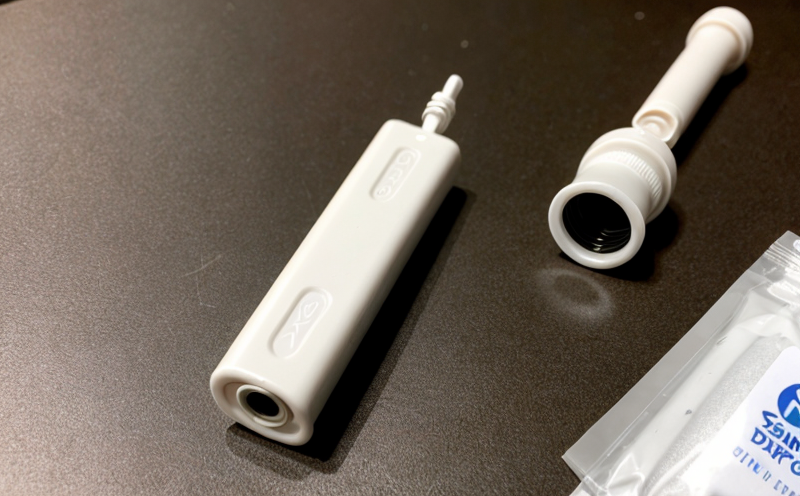ISO 9626 Needle Bending Resistance Testing
The ISO 9626 standard outlines the method for determining the bending resistance of needles, which is a critical parameter in ensuring safety and efficacy. This testing ensures that single-use medical devices meet stringent quality standards before they reach patients.
Bending resistance tests are performed on various types of needles used in medical devices such as syringes, IV catheters, and other disposable instruments. The test involves subjecting the needle to a bending force until it reaches its elastic limit without permanent deformation or failure. This is crucial because even minor structural defects can lead to potential safety hazards during use.
The testing process typically requires precise calibration of equipment and standardized procedures to ensure accurate results. Laboratories performing this service must adhere strictly to ISO 9626 guidelines, which include specific specimen preparation steps and force application methods. These stringent requirements are necessary to maintain consistency across different batches and manufacturers.
One key aspect of the testing process is the choice of materials used in needle production. Different alloys have varying bending resistance properties, influencing how they perform under stress conditions. For instance, stainless steel needles generally exhibit higher bending resistance compared to those made from cheaper metals like aluminum. Understanding material characteristics helps tailor tests according to expected outcomes.
Another important factor is the design geometry of the needles being tested. Factors such as gauge thickness, length-to-diameter ratio, and curvature influence both the initial stiffness and ultimate breaking point during testing. By accounting for these variables, laboratories can provide more comprehensive reports that account for all relevant parameters affecting bending behavior.
The results from ISO 9626 needle bending resistance tests serve several purposes within the medical device industry:
- Ensuring compliance with regulatory requirements,
- Providing data needed by R&D teams to optimize designs, and
- Offering assurance to end-users about product safety.
In summary, ISO 9626 needle bending resistance testing plays a vital role in safeguarding public health by preventing potentially dangerous products from entering clinical practice. Through rigorous evaluation of physical properties like elasticity and strength, this service contributes significantly towards maintaining high standards throughout the manufacturing process.
| Use Case | Description |
|---|---|
| Syringe Production | Determining optimal needle materials for cost-effective yet robust syringe designs. |
| IV Catheter Development | Evaluating catheters' ability to withstand repeated use without compromising safety or performance. |
| Sterility Assurance | Ensuring needles remain intact during sterilization processes, maintaining integrity throughout their lifecycle. |
| R&D Innovation | Identifying new alloys and geometries that enhance bending resistance while reducing weight or increasing flexibility. |
| Supply Chain Management | Verifying incoming batches meet specified quality levels before release into distribution channels. |
| Post-Market Surveillance | Monitoring trends in needle performance over time, identifying areas for improvement or potential issues early on. |
| Regulatory Compliance | Avoiding costly recalls by ensuring all products comply with relevant international standards before commercialization. |
| Patient Safety | Guaranteeing that every needle used in healthcare settings functions correctly, minimizing risk of injury or infection. |
Quality and Reliability Assurance
In the context of medical device manufacturing, ensuring quality and reliability is paramount. ISO 9626 needle bending resistance testing contributes significantly to this goal by providing concrete evidence that needles will perform consistently under expected stress conditions. This not only enhances trust between manufacturers and consumers but also fosters confidence among healthcare providers who rely heavily on such devices.
For quality managers, the results of these tests offer valuable insights into product performance trends over time. By tracking changes in bending resistance across various batches or designs, they can make informed decisions about process improvements needed to maintain optimal standards. Additionally, this data supports continuous improvement initiatives aimed at enhancing overall manufacturing efficiency without compromising safety.
Compliance officers benefit greatly from ISO 9626 testing as well since it aligns with regulatory expectations set forth by bodies like the FDA and WHO. Having documented proof of conformance reduces the risk of non-compliance penalties and strengthens legal defensibility in case of product liability claims or audits.
R&D engineers find this service particularly useful when developing new products or modifying existing ones. The insights gained from testing help refine designs to better meet market needs while adhering to strict safety criteria. This collaborative effort ensures that innovations are both effective and safe for end-users.
Environmental and Sustainability Contributions
While ISO 9626 needle bending resistance testing primarily focuses on product safety, its broader implications extend beyond just immediate functionality. By ensuring that needles are robust enough to withstand the rigors of use while remaining safe for disposal after single-use, this service indirectly supports environmental sustainability goals.
The development and implementation of sustainable practices within the medical device industry have gained significant attention in recent years. Manufacturers are increasingly exploring ways to reduce waste generation by using more recyclable materials or designing products that can be easily recycled post-consumer use. ISO 9626 testing plays a role here too, as it helps identify which materials offer better resistance during bending forces without sacrificing recyclability.
Moreover, by promoting consistent quality across all manufactured items, this service encourages efficient resource utilization throughout the supply chain. When suppliers know that their products must meet stringent quality benchmarks before reaching customers, there's less incentive to cut corners on production processes or material selection. This leads to reduced waste generation and lower environmental impact.
Finally, the emphasis placed on reliability through rigorous testing fosters a culture of innovation within organizations. Knowing that every product undergoes extensive evaluation before being released into circulation motivates teams to push boundaries further when it comes to developing safer, more effective solutions for patients worldwide.





